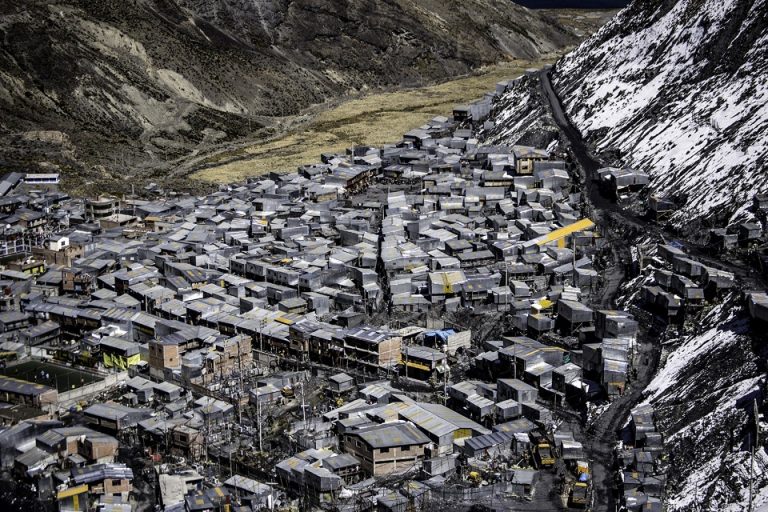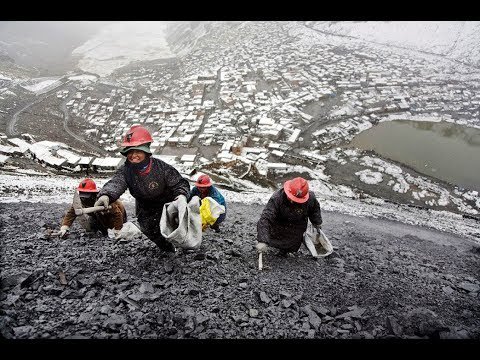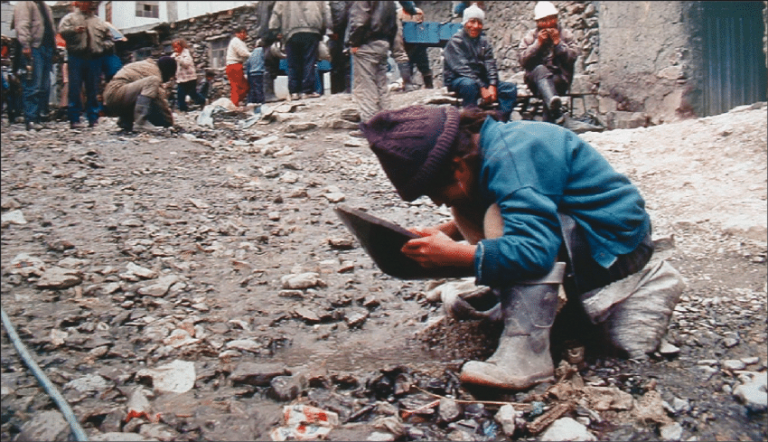La Rinconada, 5,000 to 5,400m above sea level, corrugated iron shacks, glued to the hills of the surrounding mountains, home to some 50,000 to 70,000 mining inhabitants and competing mafia mobs that control them. La Rinconada, in the Peruvian Andes, the world’s highest, chaotic, poisonous and illegal goldmines, some 210 km northeast of Puno, a 4-hour drive by car over partially paved, albeit potholed roads. La Rinconada, near the just slightly more civilized mining townof Ananea (about 4,700 m above sea level), is also considered one of the most horrific places on earth: a crime gang-run city, spreading through a valley and up the hills, no running water, no sewerage, no electricity grid. La Rinconada looks and smells like a wide-open garbage dump, infested by a slowly meandering yellowish-brownish mercury-contaminated brew – tailings from illegal goldmining – what used to be a pristine mountain lake.
The thin, oxygen-poor air is loaded with mercury vapor that slowly penetrates people’s lungs, affecting over time the nervous system, memory, body motor, leading often to paralysis and early death. Average life expectancy of a mine worker is 30-35years, about half of Peruvian’s average life expectancy.

Source: amusingplanet.com
Life has no value. People are killed for carrying a rock that may contain some tiny veins of gold. Bodies are often just thrown on to garbage heaps to rot. Occasionally a body is found and then buried right on the garbage dump. It’s not unusual to find a grave right in the midst of a field of trash.
Human rights do not exist in Rinconada. Child work is common place. And so is child prostitution, women and drug trafficking. Time off is a life of drunkenness and drug deliria. Life is worthless. See also Andre Vltchek’s essay.

Small boys are used to work in underground mining galleries, where adults hardly fit. When the galleries collapse and a child – or several – dies – nobody cares.
Many are not even identified. Most likely they are not missed. They are children of non-parents, like in non-humans, those that run this hellish mining industry, and those who send their children there to help them make a living.
No love, no ethics, no respect for nothing but the legendary gold nugget, for greed and necessity. No mercy.That’s La Rinconada.
Miners come voluntarily. Nobody forces them. Most are poor. Some are just greedy – the never-dying ‘Gold Rausch’ attracts them.
The dream of getting rich in the goldmine makes them accept the most horrendous working and living conditions: surviving in an open dump-ground of everything, garbage, toxic heavy metals, wading in mercury-polluted tailings, thin air, contaminated by poisonous vapors, no heating, most of the year sub-freezing temperatures –trash and debris everywhere.
But the miners don’t complain. Some bring their wives, few bring also their kids – it’s their choice. Some stay ‘temporarily’ only, 6 months, 12 months, 2 years? – For some the dream of hitting the riches never dies; they stay until they die. – They know they will be abused, enslaved. They know, they can take it or leave it.
Miners work for usually long hours and are working during 29 days for free. On the 30th day they may keep whatever they take out of the ground, amounting to about 800 to 1,000 Soles per month (US$250 – $320). Sometimes day 30 brings nothing. Sometimes some rocks with traces of gold.
All are hoping for a gold nugget. This type of mining wage is not unique to Peru. Bolivia and other Andean countries that are open to the most environmentally and socially destructive industry – mining – apply similar systems.
The illusion to hit it BIG by finding the legendary ‘gold rock’ is a passion; it is obsessive. And if and when a miner does find a treasure to keep, he is vulnerable of being robbed, even killed, body discarded – another miner gone missing.
Or not. Just disappeared. Maybe in a garbage dump. They are endless in Rinconada. They reflect the character of Rinconada. Refuse, waste, stench and death.

Source: researchgate
Nobody cares – or not enough to investigate the death, the missing. It’s the name of the game. Miners come by their free will. They are not coerced. They enslave themselves, in the vane hope to get rich.
Instead, they intoxicate themselves from mercury fumes, from a totally poisonous environment, daily exposure to heavy metals. Their nervous system slowly but surely fails them. Memory loss; brain damage, muscular dystrophy, collapsing lungs, paralysis, early death.
For many, it’s a dream gone dead. That’s what poverty does; it kills while dreaming of a better world.
Rinconada – mafia rules. Police work in connivance. Murders and assassinations are of the order. Prostitution, alcohol and drug abuse is rampant. Nobody cares. It’s survival of the fittest – and often survival succumbs to hardship, misery and yet hope for a better life.
These criminal organizations are all local, meaning from the vicinity, Puno, Juliaca and thereabouts. No foreign mining companies are allowed. They, huge world (in)famous gold and precious metals corporations, are waiting ‘downstream’ to buy the blood-ware, without identity, without origins. So that nobody can trace them to the crime.
Women generally do not work in the mines. Superstition. They bring bad luck. They make the gold veins disappear. They distract the men. The mines are masculine.
Only men are allowed to work them. The mountains may get jealous, and who knows what jealousy is capable of doing.
Women have other chores: collecting loose rocks that may contain some remnants of gold; they clean, prepare food, mind the household, children, if a family is unwise enough to bring their offspring to this hellhole – and, they are “taking care of the men”, in more ways than one.
La Rinconada – one of the most horrible places on earth. Hardly known to the rest of the world. Most people in Lima, the capital of Peru, have no idea that Rinconada exists, and if they have heard the name, they associate it with a lush country club in the elite district of “La Molina” of Lima. – They don’t know what it also stands for – The Devil’s Paradise.
What Rinconada produces is “blood gold”, akin to blood diamonds, blood emeralds in other parts of the world.
Who buys this gold?
Large corporations. One of them is the Swiss registered Metalor, One of the world’s largest gold foundries. Annually, about 3,000 to 3,500 tons of gold are mined across the globe. Switzerland refines about 70% to 80% of all the gold in the world.
An estimated 20% to 30% of it is considered ‘blood gold’ – gold that stems from illicit mining practices, child labor, environmental and social destructions, land theft, corruption – like from Rinconada.
As of now, Switzerland, the host of the globe’s largest mining corporations and gold foundries does not want to know the origin of the gold – possibly the environmentally and socially most destructive precious metal. Switzerland does not impose a code of ethics on the corporations that enjoy the Swiss tax-haven.
The Swiss Government pretends that these mining corporations have their own codes of conduct, and the Swiss authorities trust that they adhere to their own standards of ethics. What an easy way out!
When challenged with evidence to the contrary, i.e. Rinconada, or Espinar (also Peru), where Glencore beats up defenseless indigenous women, because they attempt to protect their properties and water from Glencore’s illegal confiscation – with the corrupt help of the local Peruvian authorities – the Swiss authorities close their eyes to open crimes of their corporations and if pressed, they simply say, “if we are too harsh with them, they will leave Switzerland” – and – “if they are doing something illegal, they are responsible to their host country”, apparently ignoring that corruption buys everything in most of these “host countries”.
That’s the level of ethics one of the richest and reputedly most noble countries of the universe applies to keep her corporations happy.
Naturally, Switzerland is also the only OECD member that allows her parliamentarians to sit in as many corporate Boards of Directors as they wish. Imagine! – A totally legalized conflict of interest.
And nobody says ‘beep’. The Swiss populace just accepts this blunt aberration – most of them don’t even know it exists.
They live comfortably and well, and don’t care much about Human Rights abusing corporations, and less so that their Parliament is a humongous built-in corporate and banking lobby. In this environment of white-collar illicit behavior, corporations like Metalor and Glencore flourish.
A recently launched people’s referendum propagating ‘Responsible Mining’, was undermined in the Swiss Parliament by the ‘built-in’ mining lobby. It is common practice that Parliament, as well as the executive give their votum before the public vote on a referendum, another unfair practice, as it influences the voters’ final decision.
*
In the meantime, the Government of Peru accuses the Swiss foundry Metalor of financing and buying tons of gold from suspicious sources in Peru, meaning illicit gold – or ‘blood gold’. Metalor is also investigated for participating in organized crime and money laundering from illicit gold deals (OjoPúblico, Peru, 14 March 2019):
“The Metalor Group was the exclusive importer of gold from illegal mining, sold or shipped by Minerales del Sur SRL (Minersur) in the period from 2001 to 2018 in the amount of more than US$ 3.5 billion. Metalor is headquartered in the Canton of Neuchatel, Switzerland.”
Metalor is also being investigated for financing Minersur’s purchasing and sales transactions of gold from illegal sources. One of these illegal sources is La Rinconada.
Other illegal sources stem from gold-digging in Peru’s Madre de Dios Amazon Region, where thousands of hectares of rainforest are being raided and devastated by mafia-type organizations, similar to the ones in Rinconada.
Metalor denies the accusation, saying they only deal with reputable mining corporations. The case is wide open and the stench of illegality that has been permeating Metalor for many years is as sickening as Rinconada itself.
What is it about gold that makes it destroy the environment, precious fresh water resources, the human spirit, sowing conflict among entire societies, abolishing their social fabric and bringing death to countless millions for centuries in exploited and abused regions of the globe? – The real industrial value of gold is only about 15% to 20% of its speculative market value.
But the gold fever is such that banks invented ‘paper gold’, meaning that Mr. and Mrs. Anybody can buy gold without ever seeing the gold bar.
The bank simply issues a certificate, an IOU for a certain amount of gold which, in theory, could be exchanged for the real thing at any time Madame Anybody would like to keep her gold bar in her personal household vault.
Not so easy. There is more than 100 times more paper gold floating around than real gold is available on the market. If everybody would like to exchange their paper gold into real gold, the banking system would collapse, or would just simply fail to deliver.
Case in point was Germany. By tradition Germany had about 1,200 tons of gold, worth about US$ 50 billion, deposited in the FED in New York.
In 2013, when the Germansawareness that their gold is being stored outside ofGerman borders resulted in a public outcry, the Bundesbank wanted to withdraw and repatriate all of their foreign stored gold by 2020, but the FED said no, they could not deliver.
The gold was simply not available. Was the FED using the German gold and the gold of so many other countries deposited in the FED’s treasuries for speculation – rent seeking with somebody else’s assets?
Blood and crime are intimately linked to gold, it seems. Our western monetary system was for a long time backed by gold. Today, western moneys are fiat money, not even backed by gold, just hot air. But the Russian ruble and the Chinese yuan are backed by gold, as well as by their respective economies. –
Who knows – as a last-ditch effort to save US-dollar and the western fiat money pyramid from collapsing, the west may again revert to some kind of gold standard, a man-made folly, when in fact, the only real value reflected in a county’s monetary system, is its economy.
*
Back to La Rinconada, Metalor and Switzerland, home of more than two thirds of the world’s gold refining – how much of the reserve gold in the coffers of countries around the world is “blood gold”? –
How many people, children and eventually entire generations have to live in misery, their health degenerating from exposure to heavy metals and eventually leading to early and painful death, until human consciousness is able to stop the gold craze? –
Closing down hellholes like Rinconada and Madre de Dios mafia-run, all-destructive gold mines? – And hundreds more of similarlydevastatingtypesmines around the world.
Perhaps when the value of gold becomes what it ought to be – its industrial value, and nothing more and nothing less, humanity becomes richer by the values of human decency and respect for each other.
*
Note to readers: please click the share buttons below. Forward this article to your email lists. Crosspost on your blog site, internet forums. etc.
Peter Koenig is an economist and geopolitical analyst. He is also a water resources and environmental specialist. He worked for over 30 years with the World Bank and the World Health Organization around the world in the fields of environment and water. He lectures at universities in the US, Europe and South America. He writes regularly for Global Research; ICH; RT; Sputnik; PressTV; The 21st Century; TeleSUR; The Vineyard of The Saker Blog, the New Eastern Outlook (NEO); and other internet sites. He is the author of Implosion – An Economic Thriller about War, Environmental Destruction and Corporate Greed – fiction based on facts and on 30 years of World Bank experience around the globe. He is also a co-author of The World Order and Revolution! – Essays from the Resistance. He is a Research Associate of the Centre for Research on Globalization.
This article was originally published on New Eastern Outlook.
The 21st Century
